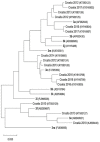Seroprevalence Trends and Molecular Epidemiology of Viral Hepatitis in Croatia
- PMID: 36676173
- PMCID: PMC9865277
- DOI: 10.3390/life13010224
Seroprevalence Trends and Molecular Epidemiology of Viral Hepatitis in Croatia
Abstract
Viral hepatitis is a significant cause of morbidity and mortality worldwide. In Croatia, hepatitis B virus (HBV) and hepatitis C virus (HCV) are widely distributed, especially in some high-risk groups such as people who inject drugs (PWID), prisoners, and highly promiscuous groups. The seroprevalence of HBV ranges from 7.0% in the general population to 38.8% in PWID, depending on the region. The seroprevalence of HCV is highest among PWID (29-75.5%) as compared to 0.9% in the general population. Analyzing the distribution of HCV genotypes, no substantial changes in the molecular epidemiology of the two most frequent HCV genotypes (1 and 3) in the past 20 years were observed. However, the predominance of subtype 1b compared to subtype 1a as detected in 1996-2005 was not confirmed in 2008-2015. Hepatitis A virus (HAV) incidence was high in the past with a decreasing trend since the 2000s, except for an outbreak in 2017-2018 as part of the large European outbreak, which was mainly among men who have sex with men. Hepatitis E virus (HEV) is an emerging virus detected for the first time in Croatia in 2012. The seroprevalence of HEV is high among hemodialysis patients (27.9%) and liver transplant recipients (19.3-24.4%). In addition, higher seroprevalence rates were observed in animal-related professions (e.g., veterinarians, 15.2%; hunters, 14.9%). All detected HEV strains belonged to genotype 3.
Keywords: Croatia; Hepatotropic viruses (A–E); molecular epidemiology; seroprevalence.
Conflict of interest statement
The authors declare no conflict of interest. The funders had no role in the design of the study; in the collection, analyses, or interpretation of data; in the writing of the manuscript; in the decision to publish the results.
Figures






References
-
- Chakravarti A., Bharara T. Epidemiology of hepatitis A: Past and current trends. In: Streba C.-T., Vere C.C., Tripodi V., Rogoveanu I., Lucangioli S., editors. Hepatitis A and Other Associated Hepatobiliary Diseases. IntechOpen; London, UK: 2019. - DOI
-
- Mićović V., Cattunar A., Stimac D., Capak K., Stojanovic D., Jurisic D. Emerging risk for viral hepatitis A in Croatian adults. Med. Glas. (Zenica) 2010;7:169–172. - PubMed
-
- Vilibić-Čavlek T., Kolarić B., Pavlić J., Kosanović-Ličina M.L., Nemeth-Blažić T. Seroprevalence and Risk Factors for HIV, Hepatitis B, and Syphilis in Populations with High-Risk Behaviors in Croatia. Acta Dermatovenerol. Croat. 2018;26:314–320. - PubMed
Publication types
Grants and funding
LinkOut - more resources
Full Text Sources
Miscellaneous

